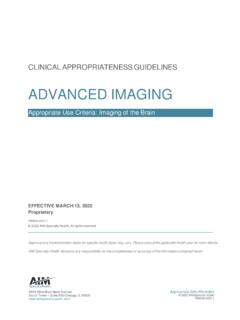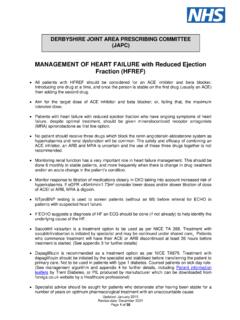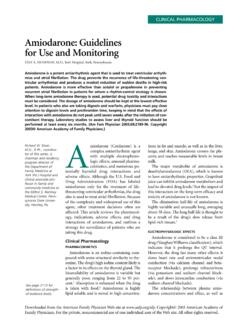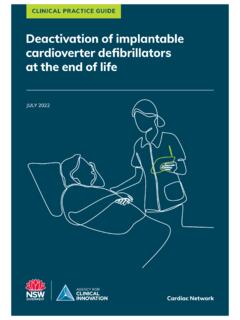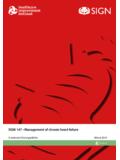Transcription of Guidance on applying human factors and usability ... - GOV.UK
1 Guidance on applying human factors and usability engineering to medical devices including drug-device combination products in Great Britain Version January 2021 human factors and usability engineering MHRA January 2021 Page 2 of 35 Contents 1 Introduction and context .. 4 2 The regulatory framework .. 7 3 Standards .. 10 4 Summary of a usability engineering process .. 13 5 Stages of a usability engineering process .. 19 6 Post-market surveillance .. 24 7 Product life-cycle and continuous improvement .. 25 8 Drug delivery devices and drug-device combination products .. 27 9 Appendix 1 .. 29 10 Appendix 2 .. 30 11 Further reading .. 32 12 References .. 33 human factors and usability engineering MHRA January 2021 Page 3 of 35 The Medicines and Healthcare products Regulatory Agency is an Executive Agency of the Department of Health and Social Care and a government trading fund, with a mission to protect and improve the health of millions of people every day through the effective regulation of medicines, medical devices, blood and blood components, underpinned by science and research.
2 Acknowledgements The original Guidance , published on 19 September 2017, was written by the MHRA human factors Task and Finish group, with representatives from MHRA, academia, industry, NHS Improvement, NICE, Notified Bodies, professional associations and trade bodies (see appendix 1). Updates to this Guidance January 2021 This version reflects the changes to the regulation of medical devices in the UK as a result of exiting the EU. The updates are primarily around this Guidance applying to Great Britain, but also include changes in references to legislation and the introduction of the new UKCA mark. Crown copyright 2021 Produced by MHRA You may re-use this information (excluding logos) free of charge in any format or medium, under the terms of the Open Government Licence. To view this licence, visit or email: Where we have identified any third-party copyright material you will need to obtain permission from the copyright holders concerned.
3 Alternative format versions of this report are available on request from human factors and usability engineering MHRA January 2021 Page 4 of 35 1 Introduction and context This Guidance is specific to medical devices placed on the market in Great Britain (England, Wales, Scotland). For Northern Ireland, different rules apply to those in Great Britain. Refer to our Guidance for more information on the regulatory system for medical devices in Northern Ireland. The safety of medical devices, including drug-device combination products, relies on them being used as intended, as well as being reliable. This requires that those involved in designing and evaluating medical devices take into account human factors within their processes. This Guidance is intended for manufacturers of all device classes and developers of medical devices and drug-device combination products, and UK Approved Bodies responsible for assuring the quality of those devices.
4 Others, such as those involved in procurement and risk management of activities involving medical devices may also find this Guidance relevant to their roles. Physicians, NHS, NICE, and other stakeholders may find this Guidance useful, but it does not apply to them or other professionals making clinical decisions. In its simplest terms, human factors refers to how a person will interact with the systems surrounding them, including the technology they use. This will very much depend on the design of that technology, what education and training that person has, and the environment in which they will be using the technology. The science-based discipline of human factors uses knowledge from such diverse subjects as anatomy, psychology, engineering and physiology to help design products that suit the user, for more effective and safer use. human factors takes into account features of the intended user population, such as age, size, strength, cognitive ability and training.
5 It also takes into account the intended environment of use, such as hospital wards, intensive care units, ambulances, or home environment; factors such as potential competing distractions, lighting level, or urgency of use will also be considered. human factors principles have been applied in high-hazard industries such as defence, nuclear, petrochemical and transport for many years, to minimise the risks from use error and promote safe practices and take advantage of technology that anticipates and mitigates use errors. human factors in healthcare has become increasingly recognised as an important topic. Following recognition of improvements that were required in healthcare, a concordat from the National Quality Board [1], published in November 2013 described human factors in healthcare as: Enhancing clinical performance through an understanding of the effects of teamwork, tasks, equipment, workspace, culture and organisation on human behaviour and abilities and application of that knowledge in clinical settings.
6 In this document we use the term human factors to encompass other terms such as ergonomics and usability . However, for consistency with key related documents, we refer to the process of achieving usable products that address user needs and fit with their practices as usability engineering except when we quote other sources. Although the Guidance aims to clarify regulatory expectations of medical devices marketed in Great Britain, it does not represent a compliance requirement. Alternative approaches to demonstrating safe and effective use could be proposed by applicants. It applies to the design of future products and changes in user interfaces of existing products, rather than those already on the market. human factors and usability engineering MHRA January 2021 Page 5 of 35 The Guidance clarifies that usability engineering is an iterative process, involving design, testing and validation of design stages; it also requires attention to the post-market phase, since evidence may come to light while a device is being used in clinical practice that the design requires further improvement.
7 This Guidance from the MHRA is not intended to be prescriptive, but to be advisory for developers and UK Approved Bodies, recognising the importance of human factors in managing patient safety. The USA Food and Drug Administration (FDA) has extensive information and Guidance on human factors related to medical devices [2]; the MHRA Guidance is intended to be consistent with both FDA Guidance and the international standards referred to below. The Guidance will complement the work being carried out by the NHS to apply human factors approaches in the design of healthcare workplaces and practices. human factors : why they matter for patient safety A growing number of medical devices are being used for monitoring and treating patients, and errors in use leading to patient harm have been increasingly a cause for concern. Such errors may be due to poor device design, particularly where a complex user interface is involved. Medical devices, such as infusion pumps, ventilators, automatic electronic defibrillators and drug-device combination products ( auto-injectors) are recognised as potentially having use-related design issues that can result in problems such as overdoses, incorrect therapy and dangerous delays or difficulties with delivery of medication.
8 As medical devices become increasingly diverse in their capabilities and the environments in which they are used becomes busier, with new distractions and requirements for specialised training, the potential for use error also increases. Furthermore, as healthcare evolves and patient care is transferred to the home or public environment, less skilled or even unskilled users, including patients and carers, must be able to use quite complex medical devices safely. Figure 1 human factors affect outcomes of using medical devices Safe / effective Ineffective Unsafe Users Use environment Device user interface Device is used human factors considerations Outcomes human factors and usability engineering MHRA January 2021 Page 6 of 35 Adapted from: FDA s applying human factors and usability Engineering to Medical Devices Guidance February 2016 [2] A usability engineering process can, and should, be applied by device manufacturers in the identification, assessment and mitigation of potential patient and user safety risks; also in the analysis of incidents that have occurred, in order to identify learning and put into place corrective actions to improve device design.
9 This Guidance focuses on ways in which human factors can be applied to medical devices, so that they are designed and optimised for use by intended users, in the environment in which they are likely to be used, for safe and effective performance. Defining the terms Ergonomics (or human factors ) is the scientific discipline concerned with the understanding of interactions among humans and other elements of a system, and the profession that applies theory, principles, data and methods to design in order to optimize human well-being and overall system performance. [3] The following definitions are from the standard BS EN 62366 Part 1 2015: Application of usability engineering to medical devices [4] Please refer to this standard for the definition of other terms (see section 3 on standards below). Abnormal use conscious, intentional act or intentional omission of an act that is counter to or violates normal use and is also beyond any further reasonable means of user interface-related risk control by the manufacturer.
10 Examples: Reckless use or sabotage or intentional disregard of information for safety are such acts. usability engineering human factors engineering application of knowledge about human behaviour, abilities, limitations, and other characteristics to the design of medical devices (including software), systems and tasks to achieve adequate usability . Note Achieving adequate usability can result in acceptable RISK related to use. Use error user action or lack of user action while using the medical device that leads to a different result than that intended by the manufacturer or expected by the user. Notes use error includes the inability of the user to complete a task use errors can result from a mismatch between the characteristics of the user, user interface, task, or use environment users might be aware or unaware that a use error has occurred an unexpected physiological response of the patient is not by itself considered use error a malfunction of a medical device that causes an unexpected result is not considered a use error.










